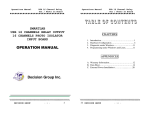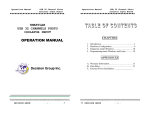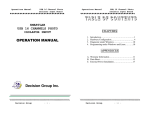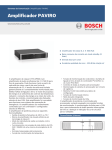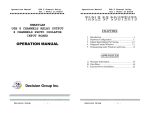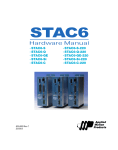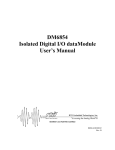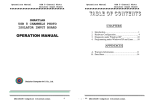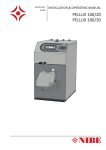Download 5624 Opto-isolated I/O
Transcript
O C T S Y S A T G E O M N S Embedded PCs For Extreme Environments 5624 Isolated Digital I/O Card User’s Manual 3702(0903) Copyright Micro PC™, PC SmartLINK™, CAMBASIC, Octagon Systems Corporation®, the Octagon logo and the Micro PC logo are trademarks of Octagon Systems Corporation. Disclaimer Copyright 2003—Octagon Systems Corporation. All rights reserved. However, any part of this document may be reproduced, provided that Octagon Systems Corporation is cited as the source. The contents of this manual and the specifications herein may change without notice. The information contained in this manual is believed to be correct. However, Octagon assumes no responsibility for any of the circuits described herein, conveys no license under any patent or other right, and makes no representations that the circuits are free from patent infringement. Octagon makes no representation or warranty that such applications will be suitable for the use specified without further testing or modification. Octagon Systems Corporation general policy does not recommend the use of its products in life support applications where the failure or malfunction of a component may directly threaten life or injury. It is a Condition of Sale that the user of Octagon products in life support applications assumes all the risk of such use and indemnifies Octagon against all damage. st 6510 W. 91 Ave. Westminster, CO 80031 Technical support: 303–426–4521 Telephone: 303–430–1500 FAX: 303–426–8126 Web site: www.octagonsystems.com 2 IMPORTANT! Please read the following section before installing your product: Octagon’s products are designed to be high in performance while consuming very little power. In order to maintain this advantage, CMOS circuitry is used. CMOS chips have specific needs and some special requirements that the user must be aware of. Read the following to help avoid damage to your card from the use of CMOS chips. Using CMOS circuitry in industrial control Industrial computers originally used LSTTL circuits. Because many PC components are used in laptop computers, IC manufacturers are exclusively using CMOS technology. Both TTL and CMOS have failure mechanisms, but they are different. Described below are some of the failures which are common to all manufacturers of CMOS equipment. However, much of the information has been put in the context of the Micro PC. Octagon has developed a reliable database of customer–induced, field failures. The average MTBF of Micro PC cards exceeds 11 years, yet there are failures. Most failures have been identified as customer– induced, but there is a small percentage that cannot be identified. As expected, virtually all the failures occur when bringing up the first system. On subsequent systems, the failure rate drops dramatically. • Approximately 20% of the returned cards are problem–free. These cards, typically, have the wrong jumper settings or the customer has problems with the software. This causes frustration for the customer and incurs a testing charge from Octagon. • Of the remaining 80% of the cards, 90% of these cards fail due to customer misuse and accident. Customers often cannot pinpoint the cause of the misuse. • Therefore, 72% of the returned cards are damaged through some type of misuse. Of the remaining 8%, Octagon is unable to determine the cause of the failure and repairs these cards at no charge if they are under warranty. 3 The most common failures on CPU cards are over voltage of the power supply, static discharge, and damage to the serial and parallel ports. On expansion cards, the most common failures are static discharge, over voltage of inputs, over current of outputs, and misuse of the CMOS circuitry with regards to power supply sequencing. In the case of the video cards, the most common failure is to miswire the card to the flat panel display. Miswiring can damage both the card and an expensive display. • Multiple component failures: The chance of a random component failure is very rare since the average MTBF of an Octagon card is greater than 11 years. In a 7 year study, Octagon has never found a single case where multiple IC failures were not caused by misuse or accident. It is very probable that multiple component failures indicate that they were user–induced. • Testing “dead” cards: For a card that is “completely nonfunctional”, there is a simple test to determine accidental over voltage, reverse voltage or other “forced” current situations. Unplug the card from the bus and remove all cables. Using an ordinary digital ohmmeter on the 2,000 ohm scale, measure the resistance between power and ground. Record this number. Reverse the ohmmeter leads and measure the resistance again. If the ratio of the resistances is 2:1 or greater, fault conditions most likely have occurred. A common cause is miswiring the power supply. • Improper power causes catastrophic failure: If a card has had reverse polarity or high voltage applied, replacing a failed component is not an adequate fix. Other components probably have been partially damaged or a failure mechanism has been induced. Therefore, a failure will probably occur in the future. For such cards, Octagon highly recommends that these cards be replaced. • Other over–voltage symptoms: In over–voltage situations, the programmable logic devices, EPROMs and CPU chips, usually fail in this order. The failed device may be hot to the touch. It is usually the case that only one IC will be overheated at a time. • Power sequencing: The major failure of I/O chips is caused by the external application of input voltage while the Micro PC power is off. If you apply 5V to the input of a TTL chip with the power off, nothing will happen. Applying a 5V input to a CMOS card will cause the current to flow through the input and out the 5V power pin. This current attempts to power up the card. Most inputs are rated at 25 mA maximum. When this is exceeded, the chip may be damaged. 4 • Failure on powerup: Even when there is not enough current to destroy an input described above, the chip may be destroyed when the power to the card is applied. This is due to the fact that the input current biases the IC so that it acts as a forward biased diode on powerup. This type of failure is typical on serial interface chips but can apply any IC on the card. • Under rated power supply: The board may fail to boot due to an under rated power supply. It is important that a quality power supply be used with Octagon Systems cards that has sufficient current capacity, line and load regulation, hold up time, current limiting, and minimum ripple. It is extremely import to select a supply that ramps up in 10ms or less. This assures that all the circuitry on the CPU cards sequences properly and avoids system lockup. • Excessive signal lead lengths: Another source of failure that was identified years ago at Octagon was excessive lead lengths on digital inputs. Long leads act as an antenna to pick up noise. They can also act as unterminated transmission lines. When 5V is switch onto a line, it creates a transient waveform. Octagon has seen sub-microsecond pulses of 8V or more. The solution is to place a capacitor, for example 0.1 µF, across the switch contact. This will also eliminate radio frequency and other high frequency pickup. 5 Table of Contents Copyright.................................................................................................................... 2 Disclaimer .................................................................................................................. 2 Using CMOS circuitry in industrial control................................................................ 3 Table of Contents............................................................................................................. 6 List of Figures.................................................................................................................. 7 List of Tables.................................................................................................................... 8 Chapter 1: Overview....................................................................................................... 9 Description .................................................................................................................... 9 Chapter 2: Installation ................................................................................................. 10 Hardware installation ................................................................................................ 10 Using a Micro PC card cage .................................................................................... 10 Component locations ............................................................................................... 11 5624 Installation......................................................................................................... 12 Base address ............................................................................................................ 13 Ports ............................................................................................................................ 14 Inputs ....................................................................................................................... 14 Example................................................................................................................. 15 Outputs..................................................................................................................... 15 Example................................................................................................................. 15 Access LED............................................................................................................... 15 Technical specifications.............................................................................................. 17 Inputs ....................................................................................................................... 17 Outputs..................................................................................................................... 17 Power requirements ................................................................................................ 17 Environmental specifications.................................................................................. 17 Warranty ........................................................................................................................ 18 Limitations on warranty ......................................................................................... 18 Service policy ........................................................................................................... 18 Returning a product for repair................................................................................ 19 Returns..................................................................................................................... 19 Governing law .......................................................................................................... 19 6 List of Figures Figure 1 Figure 2 Figure 3 5624 component diagram............................................................................. 11 Edge connector orientation.......................................................................... 12 Populated Micro PC card cage..................................................................... 12 7 List of Tables Table 1 Table 2 Table 3 Table 4 Table 5 Table 6 W1 jumper – base address select ................................................................ 13 Resistor networks ........................................................................................ 14 Resistor network and channel designators ................................................ 14 Suggested resistor networks ....................................................................... 15 J1 connector – input lines............................................................................ 16 J2 connector – input/output lines................................................................ 16 8 Chapter 1: Overview Description The 5624 Isolated Digital I/O card accepts switch closures, PLC and 12V logic inputs and other voltages that can not be used with standard TTL logic. The card supports 16 input channels and 8 output channels. The inputs have 500V of isolation to ground and 100V between channels. The eight output channels will drive relays, lamps, small motors, and solenoids. Each channel can switch loads up to 200 mA and 50V. Signals may be AC or DC. Each output is isolated from each other and the system. As shipped, the 5624 will accept signals from 2.7–14V DC. Plug–in resistor packs allows the user to accommodate ranges from 3V to 84V. The 5624 is protected from accidental reverse polarity. Noise filtering is provided, and the system is not damaged by 200V noise pulses. All inputs are isolated from each other and the system ground. The card measures 4.5 x 4.9 inches and operates on +5V. It is compatible with all Micro PC Control cards and Microcontrollers and can be installed in an ISA slot in a desktop PC. 9 Chapter 2: Installation The 5624 Isolated Digital I/O card uses one slot of the Micro PC card cage and can plug directly into any slot in the backplane. Hardware installation WARNING! The 5624 card contains static-sensitive CMOS components. The card is most susceptible to damage when it is plugged into a backplane. The 5624 card becomes charged by the user, and the static discharges to the system. To avoid damaging your card and its components: Ground yourself before handling the card Disconnect power before removing or inserting the card. Using a Micro PC card cage To install the 5624 card in a Micro PC card cage, you will need the following equipment (or equivalent): 5624 Isolated Digital I/O card Micro PC card cage (5xxx Card Cage) Power module (510x or 71xx Power Module) Octagon Micro PC CPU or Microcontroller card 10 Component locations Figure 1 shows the 5624 Isolated Digital I/O card component diagram. Refer to this diagram before connecting the 5624 card. Figure 1 5624 component diagram DIP Resistor Network Base Address Select 1 Access Indicator 2 W1 RN6 J1 RN7 RN9 RN10 J2 = Pin 1 U15 U14 U13 U12 U11 U10 U9 U8 Solid-state Relays 11 5624 Installation To install the 5624 card into a card cage: 1. Refer to the component diagram, Figure 1, for the location of various connectors and jumpers before installing the 5624 card. 2. Verify the base address settings are correct for your application. Refer to the Base Address section to select the base address. 3. Make sure power to the card cage is OFF. 4. Correctly orient the card. The components on the card should face away from the power supply. Refer to Figure 2 for correct orientation of the card into a backplane. Figure 2 Edge connector orientation A31 B31 Micro PC Passive Back-plane Card edge pins A31 & B31 Micro PC card A1 B1 Card edge pins A1 & B1 5. Slide the 5624 card into the card cage. See Figure 3 for an illustration of a 5624 card in a Micro PC card cage. Figure 3 Populated Micro PC card cage 12 WARNING! Plugging in the card incorrectly will destroy the card! 6. Power on the system. When removing the 5624 from the backplane, make sure to first disable power to your system. Base address The 5624 is configured at the factory to operate in most systems without any jumper changes. Jumper block W1 defines the base address. Refer to Figure 1 for the location of W1. As shipped, the base address is 100H, which is jumper configuration W1[1-2] [3-4] [5-6]. If there is another card in your system with a base address of 100H, you must use a different base address for the 5624 or the other expansion card. To change the base address, change the jumper configuration according to Table 1. Table 1 W1 jumper – base address select Pins Jumpered [1-2] [3-4] [5-6]* [3-4] [5-6] [1-2] [5-6] [5-6] [1-2] [3-4] [3-4] [1-2] Not jumpered * default Base Address 100H 110H 120H 130H 140H 150H 160H 170H 13 Ports Inputs The 5624 inputs are optically isolated and are capable of receiving high voltage level inputs. If the input voltage level is below the threshold level, a logic zero is read. If the input voltage is above the threshold voltage, a logic one is read. The inputs require a minimum of 1 mA at the threshold voltage in order to turn on. The input thresholds are programmed by using DIP resistor packs. The resistor value and the associated threshold are listed in Table 2. Table 2 Resistor networks 5624 resistors: RN6, RN7, RN9, and RN10 Maximum Resistor network Typical allowed value (ohms) threshold (volts) (volts) 510 ohms * 2.7 14 1K ohms 2.8 27 4.7K ohms 8.8 58 10K ohms 17 84 * default Each DIP resistor pack affects four adjacent inputs. The DIP resistors reference designators and the associated input channels are listed in Table 3. Table 3 Resistor network and channel designators 5624 resistor designators Reference designators Input channels RN6 0, 1, 2, 3 RN7 4, 5, 6, 7 RN9 8, 9, 10, 11 RN10 12, 13, 14, 15 If your application requires a different input threshold than the factory default, Table 4 lists the resistor packs recommended for replacement at locations RN6, RN7, RN9 or RN10. 14 Table 4 Suggested resistor networks Bourns – www.bourns.com Part number Resistor value 4116R-001-511 510 ohms 4116R-001-102 1K ohms 4116R-001-472 4.7K ohms 4116R-001-103 10K ohms The inputs also use a .01 uF capacitor and a 2.2K ohm resistor across the LED in order to debounce switch and relay contacts. The inputs are designed for input frequencies from 0 to 4KHz. Example The following statement is an example of how to read an input on the 5624: A = INP(&H100) 'Read 1st 8 bit port from address 100H B = INP (&H104) 'Read 2nd 8 bit port from address 104H Outputs The 5624 provides eight isolated solid–state relays for outputs. The outputs may switch both AC and DC loads. The loads may be connected to either the OUT+ or the OUT– terminal. The DC load voltage may be connected in either polarity. The rated load for an output is 200 mA at 50V. This applies to both AC and DC loads. Example Writing a logic one to the output causes the output switch to close. Writing a logic zero to the output causes the switch to open. The following statement is an example of how to write an output for the 5624: 'Output 00000001 to address 108H OUT &H100 + 8, &H01 Access LED The amber LED will light briefly whenever the card is accessed (input or output.) 15 Port pinouts J1 and J2 are 26–position headers. Of the 16 input lines, the first 12, IN0 to IN11, are connected to J1. The remaining 4 input lines, IN12 to IN15, are connected to J2. All 8 output lines are connected to J2. Refer to Tables 5 and 6. Table 5 J1 connector – input lines Pin # 1 2 3 4 5 6 7 8 9 10 11 12 13 Table 6 Description IN0+ IN0IN1+ IN1IN2+ IN2IN3+ IN3IN4+ IN4IN5+ IN5IN6+ Pin # 14 15 16 17 18 19 20 21 22 23 24 25 26 Description IN6IN7+ IN7IN8+ IN8IN9+ IN9IN10+ IN10IN11+ IN11 nc nc J2 connector – input/output lines Pin # 1 2 3 4 5 6 7 8 9 10 11 12 13 Description IN12+ IN12IN13+ IN13IN14+ IN14IN15+ IN15Nc Nc OUT0+ OUT0OUT1+ Pin # 14 15 16 17 18 19 20 21 22 23 24 25 26 16 Description OUT1OUT2+ OUT2OUT3+ OUT3OUT4+ OUT4OUT5+ OUT5OUT6+ OUT6OUT7+ OUT7- Technical specifications Inputs 2.7–14 VDC – as shipped 2.8–27 VDC – resistor pack option 8.8–58 VDC – resistor pack option 17–84 VDC – resistor pack option Input current: 1–5 mA Programmable threshold: 2.8V, 8.8V, 17V Isolation to system: 500 VDC Isolation between channels: 100 VDC reverse polarity protection; reverse voltage may not exceed range Frequency range: 0 - 4KHz Outputs 50 VDC or 50 VAC maximum Output load current: 200 mA maximum Switch resistance: 3.0 ohm maximum Isolation to system: 500 VDC isolation between channels; 100 Vpk reverse polarity protection Power requirements 5V, 100 mA maximum Environmental specifications –40° to 70° C operating –50° to 85° C nonoperating RH 5% to 95%, noncondensing 17 Warranty Octagon Systems Corporation (Octagon), warrants that its standard hardware products will be free from defects in materials and workmanship under normal use and service for the current established warranty period. Octagon’s obligation under this warranty shall not arise until Buyer returns the defective product, freight prepaid to Octagon’s facility or another specified location. Octagon’s only responsibility under this warranty is, at its option, to replace or repair, free of charge, any defective component part of such products. Limitations on warranty The warranty set forth above does not extend to and shall not apply to: 1. Products, including software, which have been repaired or altered by other than Octagon personnel, unless Buyer has properly altered or repaired the products in accordance with procedures previously approved in writing by Octagon. 2. Products which have been subject to power supply reversal, misuse, neglect, accident, or improper installation. 3. The design, capability, capacity, or suitability for use of the Software. Software is licensed on an “AS IS” basis without warranty. The warranty and remedies set forth above are in lieu of all other warranties expressed or implied, oral or written, either in fact or by operation of law, statutory or otherwise, including warranties of merchantability and fitness for a particular purpose, which Octagon specifically disclaims. Octagon neither assumes nor authorizes any other liability in connection with the sale, installation or use of its products. Octagon shall have no liability for incidental or consequential damages of any kind arising out of the sale, delay in delivery, installation, or use of its products. Service policy 1. If a product should fail during the warranty period, it will be repaired free of charge. For out of warranty repairs, the customer will be invoiced for repair charges at current standard labor and materials rates. 2. Customers that return products for repairs, within the warranty period, and the product is found to be free of defect, may be liable for the minimum current repair charge. 18 Returning a product for repair Upon determining that repair services are required, the customer must: 1. Obtain an RMA (Return Material Authorization) number from the RMA Administrator, 303-430–1500. 2. If the request is for an out of warranty repair, a purchase order number or other acceptable information must be supplied by the customer. 3. Include a list of problems encountered along with your name, address, telephone, and RMA number. 4. Carefully package the product in an antistatic bag. Failure to package in antistatic material will VOID all warranties. Then package in a safe container for shipping. 5. Write RMA number on the outside of the box. 6. For products under warranty, the customer pays for shipping to Octagon. Octagon pays for shipping back to customer. 7. Other conditions and limitations may apply to international shipments. Note PRODUCTS RETURNED TO OCTAGON FREIGHT COLLECT OR WITHOUT AN RMA NUMBER CANNOT BE ACCEPTED AND WILL BE RETURNED FREIGHT COLLECT. Returns There will be a 15% restocking charge on returned product that is unopened and unused, if Octagon accepts such a return. Returns will not be accepted 30 days after purchase. Opened and/or used products, non–standard products, software and printed materials are not returnable without prior written agreement. Governing law This agreement is made in, governed by and shall be construed in accordance with the laws of the State of Colorado. The information in this manual is provided for reference only. Octagon does not assume any liability arising out of the application or use of the information or products described in this manual. This manual may contain or reference information and products protected by copyrights or patents. No license is conveyed under the rights of Octagon or others. 19



















